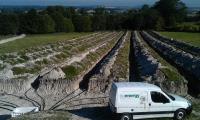 Add My Company
Add My Company
Sign In

All ground-source heat pump systems comprise of three core elements: the infrastructure providing the renewable energy resource from the ground; the heat pumps themselves; and the heat distribution system.
To date, most financial models for the technology have tended to assume that the total system has the same useful life as each of its components and therefore that the total investment should be written down at the same rate. This provides a significantly over-cautious perspective of the total costs of ownership for a ground-source heat pump system in relation to the design life of a building. This problem is then exacerbated when comparisons are being made with traditional fossil fuel plant equivalents.
The materials used for closed-loop heat collector arrays, whether in horizontal trenches, vertical boreholes, or in energy piles is a variant of polyethylene (generally PE100 polymer). This material is abrasion resistant, stress-crack resistant, not notch sensitive, resistant to rapid crack propagation in a wide temperature range (+60ºC to -30ºC) and resistant to a variety of chemicals. The fact that it does not react chemically or electrically with most surrounding soil types ensures that the pipework is not susceptible to rot, rust, corrosion or loss of wall thickness.
Polyethylene also has many mechanical benefits being flexible and lightweight, easy to install with a high degree of tolerance to ground movement and requiring of minimal maintenance. For these reasons, it is already used (and has been for many years) for a wide variety of infrastructural purposes; including both water and natural gas mains. PE materials also have the ability quickly to form highly reliable end-load resistant fusion weld joints with a strength and minimum design life equivalent to that of the pipe itself. All of the above properties contribute to an extended design life.
It is clear then that the design life of ground-source collector arrays, when installed to industry best practise, is comparable to the design life of other infrastructural deployments such as water and gas mains. Typically, this can be assumed to be several times the design life of the heat pump plant room installations which are considered to be up to about 20 years or so.
If the design life of the collector array is recognised properly then the carbon argument in support of ground-source heat pump technology becomes much easier to make. As the national grid is progressively decarbonised, the same high quality collector infrastructure will be delivering a progressively lower carbon energy resource over time. Presently the accepted CO2 figure produced per kWh of useful electricity is 495g/kWh. Using a well-designed heat pump the CO2 saving compared to natural gas is around 33% at present.
It is anticipated that in the near future the CO2 produced to generate electricity will reduce to 400g/kWh. The heat pump will then show a 46% CO2 saving. Comparisons which take into account actual gas-fired boiler efficiencies and the displacement of more carbon intensive primary fuels such as LPG, oil and direct electrical heating are even more favourable.
In summary, the case for ground-source heat pump collector arrays to be recognised as a core carbon reducing infrastructure is clear. Some utility companies are beginning to see the potential and are exploring ownership and financial models. Couple these factors to the climatic conditions in the UK which are very favourable for ground-source technology, with relatively benign winter temperatures and relatively high winter rainfall, and the potential for the ground beneath our feet to be the primary heat resource for both domestic and commercial space heating in the future is highly promising.
For more information on Ground source heat pump collector arrays as an infrastructural investment talk to ISO Energy Ltd
Enquire Now
List your company on FindTheNeedle.
